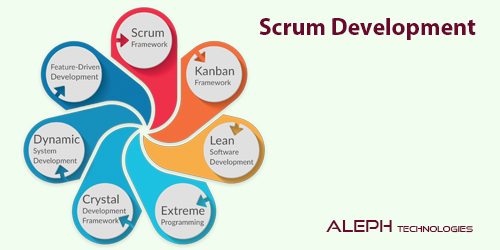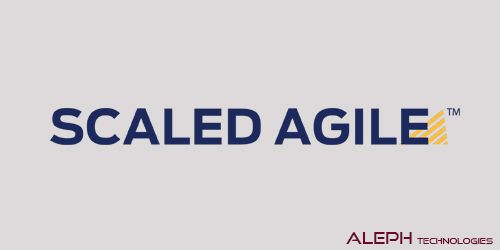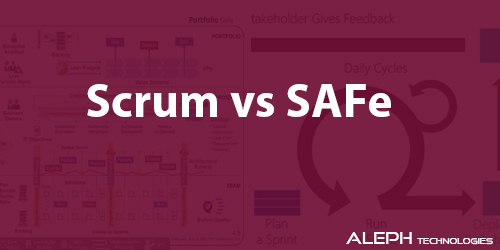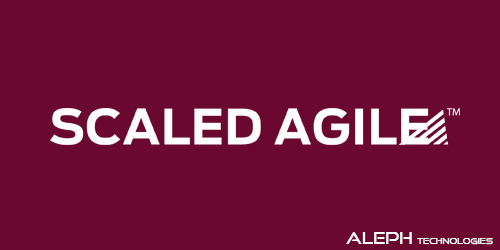🚀 Achieving Enterprise Agility: A Comprehensive Guide to SAFe® DevOps Implementation for SEO Success
Feb 22, 2024
Aleph Technologies
6 minutes read
0 comments
431 views
In today's fast-paced digital landscape, the Scaled Agile Framework (SAFe®) plays a crucial role in enhancing organizational agility to respond effectively to digital disruption. Within the SAFe framework, the integration of DevOps and Release on Demand is paramount, facilitating seamless release processes and overcoming traditional misalignments across Value Streams. In this SEO-optimized guide, we delve into the key components of SAFe® DevOps implementation and its impact on enterprise readiness.
Scrum
Agile
Scrum Master
Agile and Scrum
Scrum Master
Agile
Scrum
Agile & Scrum
SAFe® DevOps Implementation for Greater Enterprise Agility
1. The Role of DevOps in SAFe®:
SAFe® projects leverage DevOps practices to break down silos, enabling Agile Release Trains (ART) and deployment trains to continuously deliver new features to end-users. Over time, the gap between development and operations is significantly reduced, fostering a more flexible and stable production environment capable of delivering value more frequently.
2. CALMR Approach to DevOps:
Culture: Establish a culture of shared responsibility for development, deployment, and operations. 🌐
Automation: Automate the continuous delivery pipeline for efficiency and consistency. 🤖
Lean Flow: Keep batch sizes small, limit work in progress, and emphasize extreme visibility. 🔄
Measurement: Implement application telemetry to measure flow through the pipeline. 📊
Recovery: Plan and enable low-risk releases, emphasizing quick reversion and fix-forward. 🛠️
The Goal of DevOps
3. Enhancing Collaboration and Coherence:
From planning through delivery, DevOps aims to improve collaboration between Development and IT Operations by automating a continuous delivery pipeline. The benefits include increased deployment frequency, improved technology experimentation, faster time-to-market, enhanced solution quality, reduced release failures, and improved Mean Time to Recovery (MTTR).
4. Culture of Shared Responsibility in SAFe:
DevOps within SAFe relies on a culture created by embracing Lean-Agile values, principles, and practices throughout the entire structure. This includes fostering collaboration, risk tolerance, self-service infrastructure, information sharing, and an "Automate Everything" mindset.
Automate Everything for Efficient DevOps
5. Importance of Automation in DevOps:
DevOps recognizes that manual processes hinder rapid value delivery, productivity, and security. Automation is not just a time-saving measure but also enables the creation of repeatable and self-documenting processes, improving reliability. The entire continuous delivery pipeline, including ALM, relic management, build, testing, continuous integration, and deployment, is automated.
6. Key Automation Tools in DevOps:
Explore tools for Application Life Cycle Management (ALM), Relic Management Repository, Build automation, Automated testing, Continuous integration, Continuous deployment, and other crucial DevOps support tools. 🧰
Lean Flow for SAFe Success
7. Achieving Continuous Flow in SAFe:
SAFe teams strive for a state of constant flow, ensuring new features move swiftly from concept to realization. Visualizing and limiting work in progress, reducing batch sizes, and managing line lengths are essential keys to achieving flow in a DevOps context.
8. Measuring the Flow of Value:
In a DevOps environment, issue resolution becomes less complex, and telemetry provides real-time data on solution performance. Implementing application telemetry is crucial for gathering data on business and technical aspects, enabling data-driven decision-making, and continuously improving the application. 📉
Enabling Low-Risk Releases with Rapid Recovery
9. The Importance of Low-Risk Releases:
To support the continuous delivery pipeline and Release on Demand, the system must be designed for low-risk component or service-based deployments. Processes such as a stop-the-line attitude, proactive failure planning, and the ability to fix forward or roll back quickly contribute to a more flexible release process.
10. Building a Resilient Environment:
Adopting a stop-the-line attitude, planning for and practicing failures, and developing the capability to fix forward or roll back are essential strategies for managing operational failures effectively. 🌐
By implementing SAFe® DevOps with a focus on collaboration, automation, lean flow, and low-risk releases, organizations can achieve greater agility, faster time-to-market, and improved overall efficiency. Embrace these principles to navigate the complexities of the digital age successfully.
Learn more about SAFe DevOps :
Add Your Comment
Related posts
-

Scrum Development: A Comprehensive Overview 🚀
Mar 25, 2024 -

Understanding Scaled Agile (SAFe) and Disciplined Agile Delivery (DAD)
Mar 25, 2024 -

Scrum vs SAFe: Unveiling the Differences 🔄
Mar 25, 2024 -

Unlocking Business Agility with SAFe: A Comprehensive Guide 🚀
Mar 25, 2024

Please login to check comments